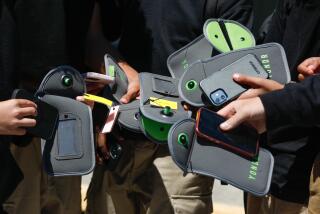L.A.’s Fat and Fizzy Campuses
- Share via
In recent months, high-profile reports on health policy have sounded the alarm about the grave risks of our nation’s bulging waistline. According to the California Department of Health Services, more than 60% of adults in Los Angeles are overweight. Perhaps more foreboding, more than 40% of school-age children weigh too much. Given the corresponding health risks--overweight and obese children are at greater risk for long-term problems such as cardiovascular disease, Type-2 diabetes, asthma and certain cancers--it is imperative that school districts across the nation move quickly to redress this crisis by increasing the selection of healthful foods in school cafeterias and reducing the availability of foods of low nutritional value on campus.
On Tuesday the Los Angeles Unified School District board will vote on a motion to remedy the district’s long-standing contradiction in policy, wherein we preach nutritional standards but continue to sell nutritionally deficient products. The motion calls on the LAUSD to discontinue the sale of soft drinks on campuses during school hours beginning in January 2004 in favor of more healthful alternatives.
Soft drinks are leading culprits in the obesity epidemic because they contribute significantly to caloric intake. A recent study found that for each soft drink consumed in a day, a child’s risk for obesity increased by 60%. Another study found that young, active girls who drank sodas were five times more likely to fracture bones than girls who did not.
Traditionally, the argument against removing soft drinks from LAUSD campuses has been based on the revenue that their sales generate for cash-strapped schools, particularly for extracurricular activities and supplies. Indeed, soft drink contracts provide thousands of dollars per year in commissions. These contracts are deemed so important to soft drink companies that they pay a sizable premium to place vending machines on campuses and thereby gain an early foothold in “branding” the lucrative youth market.
In light of the health risks, it should not be difficult to choose good health over short-term monetary compensation. That the LAUSD has chosen to allow corporate profit to eclipse its commitment to promoting good nutrition is a blatant abdication of our responsibility.
Predictably, this burden of risk falls heaviest on the shoulders of low-income students of color. African American and Latino adults have the highest rates of diabetes in the county, and the potentially deadly Type-2 diabetes is becoming more common among black and Latino children. Moreover, African American and Latino children (more than 80% of the LAUSD population) are at even greater risk of being malnourished because the high-poverty communities in which many of them live are less likely to have grocery stores with a wide selection of fresh fruit and vegetables. In addition, according to a 2000 LAUSD study, more than 25% of children in the county do not have access to preventive health care.
The district’s responsibility for providing healthful food on its campuses is not an idle luxury. Children who eat more healthful diets are more mentally alert, emotionally engaged and physically fit. Therefore, another important aspect of the motion advocates curricula that emphasize the relationship between health literacy, rigorous physical education and emotional and psychological wellness.
We must not allow the threat of lost profits to compromise our commitment to equity, especially when healthful, revenue-generating alternatives to soft drinks exist. A school district that doesn’t focus on the “total child” betrays its professed mission to provide a just and equitable school environment and effectively dooms all of its students to failure.
*
Marlene Canter and Genethia Hudley-Hayes are members of the Los Angeles Board of Education.
More to Read
Sign up for Essential California
The most important California stories and recommendations in your inbox every morning.
You may occasionally receive promotional content from the Los Angeles Times.










